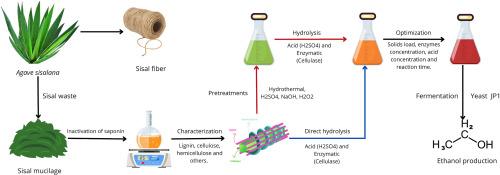Development of the second-generation ethanol production process from sisal mucilage
IF 5.8
2区 生物学
Q1 AGRICULTURAL ENGINEERING
引用次数: 0
Abstract
Sisal mucilage (SM) is a lignocellulosic material produced by extracting sisal fiber and passing it through a rotary sieve. It is estimated that only 4 wt% of the Agave sisalana plant is converted into fiber (sisal), while the remaining 96 wt% is discarded as production waste. This study aimed to valorize SM in the production of lignocellulosic ethanol without pretreatment steps. The SM was characterized and showed 39.68 ± 0.32 % cellulose, 13.12 ± 0.22 % hemicelluloses, 6.14 ± 0.5 % lignin, 30.57 ± 0.48 % extractives and 4.11 ± 0.05 % ash. The pre-treatments were harmful for ethanol production, since only lignin was broken down or the cellulose and hemicellulose fractions released HMF, furfural, and acetic acid instead of glucose and xylose. Applying hydrolysis directly on the raw mucilage showed a better response in the extraction of fermentable carbohydrates, after optimization: 101.6 g/L of glucose in enzymatic hydrolysis and 36.12 g/L of glucose in acid hydrolysis. These results agreed with the literature, which reported 100.06 g/L in Agave tequilana under pre-treatment and with enzymatic hydrolysis. The fermentation efficiency of acid and enzymatic routes was 56.86 % (0.04 g ethanol/g biomass) and 71.46 % (0.13 g ethanol/g biomass). This efficiency is a critical parameter in industrial biotechnology, directly impacting production yields, costs, and scalability. Within this context, the present study proved that it was possible to produce ethanol with SM without pretreatment processes. These results indicate opportunities for developing bioenergy value chains that may contribute to development in dry regions.

剑麻粘液第二代乙醇生产工艺的开发
剑麻粘液(SM)是通过提取剑麻纤维,并通过旋转筛生产的木质纤维素材料。据估计,只有4 wt%的龙舌兰植物转化为纤维(剑麻),而其余96 wt%被丢弃作为生产废物。本研究旨在验证SM在无预处理的木质纤维素乙醇生产中的应用。纤维素含量为39.68±0.32%,半纤维素含量为13.12±0.22%,木质素含量为6.14±0.5%,提取物含量为30.57±0.48%,灰分含量为4.11±0.05%。预处理对乙醇的生产是有害的,因为只有木质素被分解,或者纤维素和半纤维素部分释放HMF、糠醛和乙酸,而不是葡萄糖和木糖。经优化后,直接对原料胶浆进行水解对可发酵碳水化合物的提取效果较好,酶解葡萄糖为101.6 g/L,酸解葡萄糖为36.12 g/L。这些结果与文献报道的龙舌兰酒经预处理和酶解后含量为100.06 g/L的结果一致。酸法和酶法发酵效率分别为56.86% (0.04 g乙醇/g生物质)和71.46% (0.13 g乙醇/g生物质)。这种效率是工业生物技术的关键参数,直接影响产量、成本和可扩展性。在此背景下,本研究证明了SM无需预处理即可生产乙醇的可能性。这些结果表明,发展生物能源价值链可能有助于干旱地区的发展。
本文章由计算机程序翻译,如有差异,请以英文原文为准。
求助全文
约1分钟内获得全文
求助全文
来源期刊

Biomass & Bioenergy
工程技术-能源与燃料
CiteScore
11.50
自引率
3.30%
发文量
258
审稿时长
60 days
期刊介绍:
Biomass & Bioenergy is an international journal publishing original research papers and short communications, review articles and case studies on biological resources, chemical and biological processes, and biomass products for new renewable sources of energy and materials.
The scope of the journal extends to the environmental, management and economic aspects of biomass and bioenergy.
Key areas covered by the journal:
• Biomass: sources, energy crop production processes, genetic improvements, composition. Please note that research on these biomass subjects must be linked directly to bioenergy generation.
• Biological Residues: residues/rests from agricultural production, forestry and plantations (palm, sugar etc), processing industries, and municipal sources (MSW). Papers on the use of biomass residues through innovative processes/technological novelty and/or consideration of feedstock/system sustainability (or unsustainability) are welcomed. However waste treatment processes and pollution control or mitigation which are only tangentially related to bioenergy are not in the scope of the journal, as they are more suited to publications in the environmental arena. Papers that describe conventional waste streams (ie well described in existing literature) that do not empirically address ''new'' added value from the process are not suitable for submission to the journal.
• Bioenergy Processes: fermentations, thermochemical conversions, liquid and gaseous fuels, and petrochemical substitutes
• Bioenergy Utilization: direct combustion, gasification, electricity production, chemical processes, and by-product remediation
• Biomass and the Environment: carbon cycle, the net energy efficiency of bioenergy systems, assessment of sustainability, and biodiversity issues.
 求助内容:
求助内容: 应助结果提醒方式:
应助结果提醒方式:


